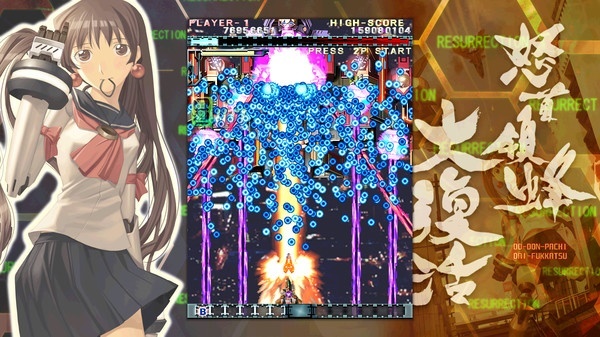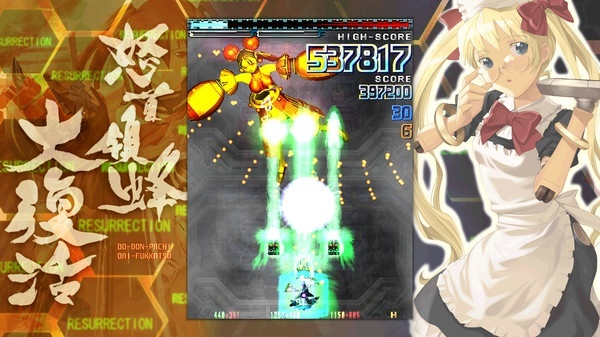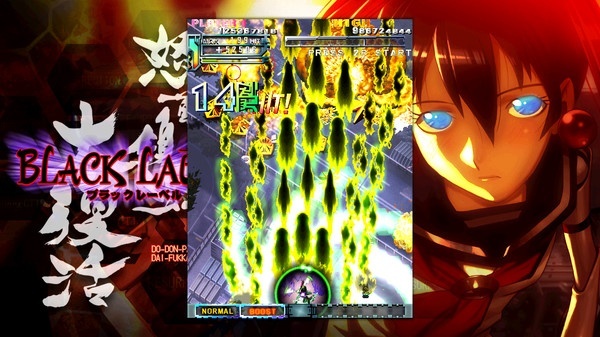DoDonPachi Resurrection (PC) Review
By Gabriel Jones  13.10.2016
13.10.2016

After destroying the supposed final boss of the arcade game DonPachi, the commander congratulates the player for completing the training mission. Apparently, everything that happened earlier was a "mock battle," except with live ammunition, and the "enemies" were actually your allies and friends. Anyway, the game must then be restarted, only it's become far more difficult. This cycle of constant war is the backdrop of Cave's longest-running STG franchise. In the fourth entry, DoDonPachi Resurrection, the lone pilot must go back in time to break this devastating cycle. Along the way, he'll confront the five Element Dolls, A.I. programs that have taken the forms of giant…cute robot girls? Well, okay, then.
Like most other 2D shooters, DoDonPachi Resurrection is relatively simple to explain, complicated to play, and nearly impossible to master. Upon starting the game, players will select their ship. Each craft is armed with a regular shot, powerful laser cannon, and a cache of bombs. Next, their style must be picked, which determines the difficulty. The "strong" and "bomb" styles are easier, while the "power" style is specifically geared for advanced play. Unlike the other two styles, power can't rely on a surplus of bombs to escape tricky situations. Instead, it offers a button to switch between normal and boost levels of firepower. Now, buckle up, because this is where it gets complicated.
The basis of this game's scoring system is in the chain. By destroying enemies or fulfilling other conditions, the hit counter will rise. The chain is lost whenever too much time passes between hits, or the player flies into a bullet. Unlike previous entries, the chain isn't nearly as difficult to hold onto. However, Cave has saw fit to include numerous hit counter raising methods. The most common one is via the use of hyper. There's a gauge at the top of the screen. When it's full, a powered-up attack can be unleashed that lasts for several seconds. While the hyper is activated, enemy bullets can be destroyed, and they're added to the counter. The larger a chain is, the fatter the multiplier bonus. To keep people from abusing the hyper, there is a ranking system. Rank rises whenever a hyper is used. Higher ranks reduce the hyper's ability to cancel bullets, as well as introduce other dangers. While players are trying to figure all this out, there's still an army and their abundance of colourful bullets attempting to destroy them.

The "whens and wheres" is what makes this game become truly convoluted. Knowing when to use the hyper and knowing where to position the ship; these are the two factors that can't be ignored by score-minded players. This isn't something that's going to be noticed early on. A good STG is designed to be played repeatedly. With every playthrough, new strategies are discovered. Gamers will notice something in stage 5 that could be applied to a similar situation in a previous stage. It's a constant cycle of refinement, and the results of a different strategy aren't always immediately obvious.
DoDonPachi Resurrection is a fairly easy game to clear; that means beating the game without continues. However, the skill ceiling is immeasurably high. There are many secrets, such as hidden "bee" items, an alternate route where the bosses of DoDonPachi make an appearance, and even second loops. The best players might even face the dreaded Hibachi, the true last boss, whose mind-melting bullet patterns and bomb-deflecting shields will exhaust all of their remaining resources. Mastering this game, or rather, the 1.5 mode, could take hundreds of hours. Wait. All of this trouble for this just one mode?
That's right; this game is divided into six modes of play. Between each mode, everything from the enemy locations and bullet patterns seem similar enough, but the underlying mechanics have received dramatic overhauls. This means everything from how scoring works to the ranking system. It's overwhelming, but eventually players will find a mode that really appeals to them. It's best to think of all these modes as a single block of marble. Over a long enough period of time, this stone can probably be sculpted into a masterpiece. The player is free to chip away at it however they prefer. The six modes have a lot of depth to them, as well as some neat changes, like their own soundtracks.

For some players, 1.5 and Black Label will take up the bulk of their time. These two modes complement each other well, with Black Label offering numerous variations on the core rules. In Black Label, cancelling out bullets with the hyper beam doesn't raise the hit counter, but there are other ways to go about it. The hidden bees are also more rewarding. If they're grabbed at the right moment, they'll turn bullets into valuable gold stars. Black Label also has a ranking bar that fills up whenever both fire buttons are held. It makes things more difficult, but it can improve the chances of getting a high score if properly managed. Choosing strong style immediately kicks the game into Hell levels of difficulty, so be wary of that. The 1.51 mode is surprisingly different. While it uses 1.5 for a base, it employs various tweaks to surprise veterans.
Black Label Arrange (aka "Ketsuipachi") is a very intriguing beast. It combines the scoring systems of both Black Label and an earlier Cave STG called Ketsui. Basically, the goal is to get close to enemies, so that when they're destroyed, they drop large hit counter boosting cubes. Afterwards, it's all a matter of using the generous supply of hypers to turn bullets into legions of gold stars. The boss battles tend to be especially profitable. This mode seems to represent an excess of everything. The score climbs well into the trillions, the slowdown is ludicrous, and playing well causes the screen to erupt in showers of cubes and stars. Somewhere underneath all of that chaos is a war or something, which isn't really important.
Arrange A is also pretty interesting. There's just one ship, and its style is automatically set to power. During hyper mode, shooting bullets adds to the hit counter, but it doesn't cause them to disappear. If the situation becomes desperate, the boost setting can be switched to to clear the air. It's a high risk/reward scenario, and is likely to frustrate those who don't plan ahead. Arrange B is just plain odd. There are unlimited lives, but only one stage is played at a time. Getting the most out of this mode requires dedicated players that aren't afraid to grind.

Although DoDonPachi Resurrection is very entertaining, it's lacking that really intense feeling. The deal with 2D shooters is that the odds are heavily stacked against the player, and they're usually piloting some dinky ship that can't take a single hit. In the face of this nightmare, the player has to play beyond their ability and achieve a new level of skill. Dodging wave after wave of bullets while the fate of the universe hangs in the balance is incredibly thrilling, or at least it's supposed to be. When the player is threading a needle in-between thousands of bullets, their immediate thought shouldn't be, "Am I efficiently maximising my scoring potential?"
It's a tricky balance, considering that after a long enough time, a veteran's biggest concern will be their score. Still, there are games out there that manage to maintain their intensity, creating this amazing sensation within. At times, DoDonPachi Resurrection feels a little too clerical, too clean. It could just be the malleability of the bullets. When a lot of bullets are getting cancelled, the enemy will fire off more to compensate. The player is given free rein to manage this situation as they see fit, but there's such a thing as too much control. Some STG fans would prefer a game where survival is entirely dependent on the fundamentals, such as dodging. Moreover, the exhilaration that comes from escaping the most hopeless of scenarios is immediately countered with thoughts like, "If I had managed my rank better, I wouldn't have nearly gotten trapped in the first place." Clearing the game isn't as exhilarating as it could be, because everything is designed within the limitations of the player. Maybe that's a testament to how thought-out the game is, but some gamers might prefer a 2D shooter that isn't so free form.
All that said, this is still an absolutely brilliant shoot 'em up package. It's so rewarding to nail the more difficult tricks, get pixel-close to disaster, and send the score into the stratosphere. Almost all of the modes are great, the visuals are fantastic, and the music is some of the best the genre has ever produced. Alongside everything else, a full suite of training options, leaderboards, and other features round out this impressive set.

Cubed3 Rating
Great - Silver Award

DoDonPachi Resurrection is a thoroughly fascinating 2D shooter. Its various systems compound onto one another to create a unique and very addictive experience. However, it takes a long time just to make sense of everything, let alone make it work to the player's advantage. At any moment, there's just so much that can go wrong, and even the best strategies are undone by the tiniest movements. Getting the most out of this game's many flavours will take a seemingly endless number of retries. It's a vicious cycle, but some gamers wouldn't have it any other way.
Comments
Comments are currently disabled

 Sign In
Sign In Game Details
Game Details
 Out now
Out now  Out now
Out now  Out now
Out now  Out now
Out now  Subscribe to this topic
Subscribe to this topic Features
Features





 Top
Top

